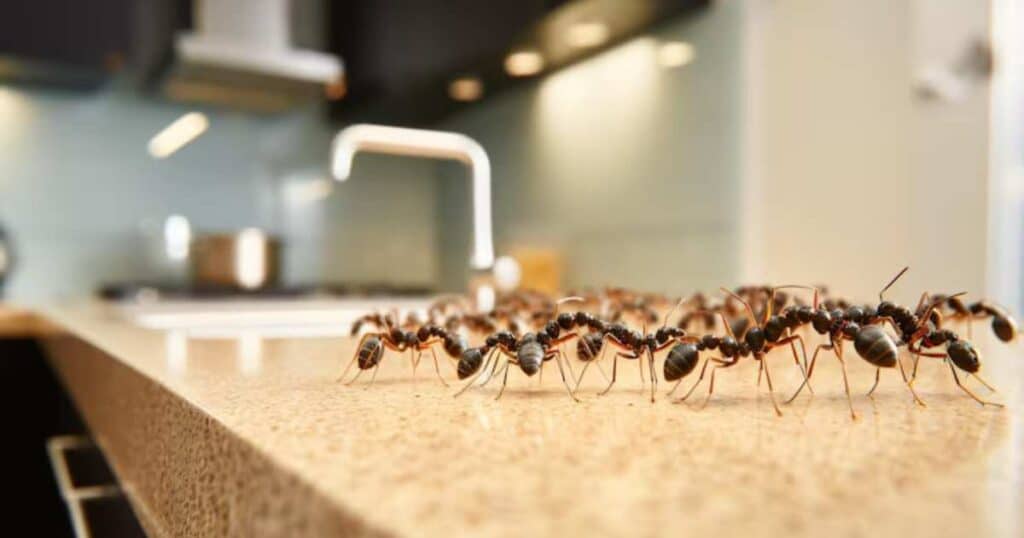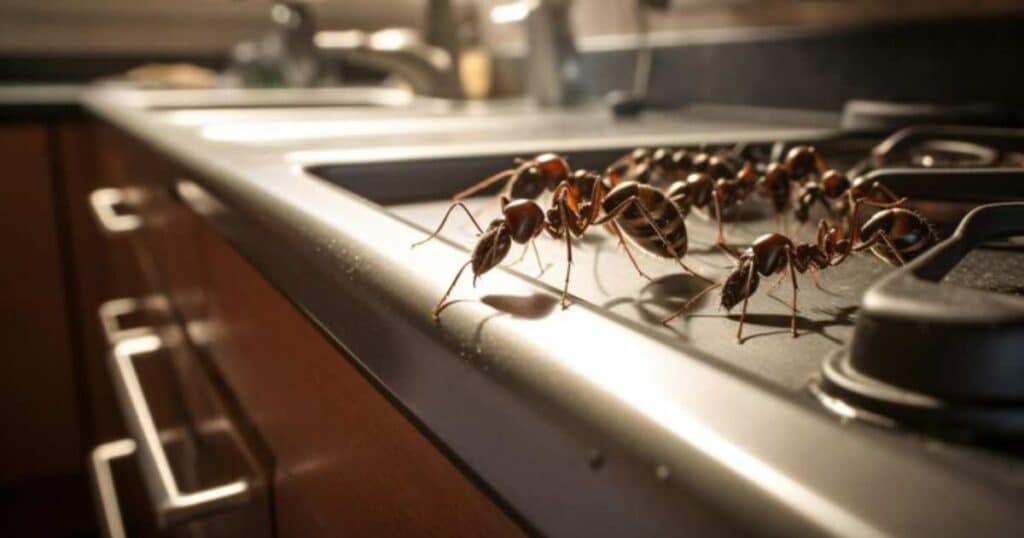There’s nothing more frustrating than navigating around tiny ant trails. These constantly invade your kitchen counters and floors.
Ant infestations can feel unavoidable, with these persistent pests finding their way inside in search of crumbs, spills, or anything edible is left out.
Not only is dealing with ants unsanitary, but some species can contaminate food. Even cause structural damage to your home over time.
Don’t resign yourself to sharing your kitchen with these unwanted guests. This comprehensive guide will cover the most effective strategies for identifying, eliminating, and preventing ant invasions for good.
Say goodbye to ants taking over your kitchen space!
Identify the Ant Species and Entry Points
The first step in getting rid of ants is identifying the entry points in your kitchen. Where they’re gaining access to your kitchen area.
Different ant species have distinct characteristics and nesting habits. Food preferences can impact the best removal method.
Some of the most common ant species that become household pests include:
- Odorous House Ants: These dark brown or black ants give off a foul, rotten smell when crushed and nest in wall and floor crevices. Their scent trails can be difficult to fully eliminate.
- Pavement Ants: Identified by their reddish-brown color and found nesting under driveways, patios, or the edges of buildings. They leave small mounds of soil around exterior entry points.
- Argentine Ants: A light brownish-gray ant that forms massive colonies and loves to feed on sugary substances. These are the ants most commonly seen creating long trails inside in search of sweets and proteins.
- Pharaoh Ants: These tiny yellow ants are only 1/16-inch long and tend to nest inside buildings near heating sources like ovens or dishwashers. Their colonies can have multiple queens making them tougher to control.
- Carpenter Ants: One of the largest ant species at 1/4 to 1/2-inch long. They nest in both moist and dry wood, which can cause serious structural damage over time if left unchecked.
Once you’ve identified the likely culprit species. Then Do a thorough inspection around your kitchen. to look for any potential entry cracks, gaps, or crevices where you notice ant trails emerging.
Pay close attention along floors, walls, windows, and areas where utilities enter the home. Use a flashlight or mirror to look in harder-to-see spots like under appliances.
Ants can squeeze through spaces as tiny as 1/32 of an inch! Leave no stone unturned in your search. Finding the ants’ main nesting spot is key for complete elimination.
While trailing ants come from the nest in search of food and water. Sources, destroying only the scouts won’t solve the overall infestation problem long-term. You need to eliminate the entire colony.
Simple & Natural Home Remedies to Deter Ants

Before turning to harsh chemicals some of the most effective and inexpensive ant deterrents can actually be found in common pantry items. The smells and tastes of certain natural products help repel and kill off foraging ants.
Here are some easy DIY recipes using ingredients you likely already have at home:
Vinegar Spray
- Mix equal parts vinegar (white or apple cider) and water in a spray bottle
- Spray along ant trails and entry points
- Vinegar disrupts the scent trails ants use to navigate and find food
Baking Soda & Powdered Sugar Trap
- Mix one part baking soda with one part powdered sugar
- Place small piles or containers of the mixture near ant trails
- Ants will consume the sweet sugar but the baking soda kills them
Lemon Juice or Essential Oil Wipe Down
- Lemon juice or peppermint/lemongrass essential oils act as strong repellents
- Mix a few drops or lemon juice with water
- Use to wipe down counters, windows, shelves anywhere you see ant activity
- The strong citrus or minty scent helps mask any trails attracting ants
Coffee Grounds
- Sprinkle dry, used coffee grounds liberally around ant entry spots and trails
- The bitter scent and abrasive texture deter ants from crossing through
Chalk Barrier
- Ants avoid crossing lines of chalk (containing calcium carbonate)
- Draw chalk lines across entry points or around plants/pet bowls
- Must be reapplied after it gets wet or too dusty
While these natural remedies can help in small, localized areas, larger or more stubborn ant infestations may require more heavy-duty treatment with chemical products to fully eliminate ants.
Last summer I dealt with a terrible odorous house ant invasion in my kitchen. I tried everything vinegar, lemon juice, cinnamon you name it.
The ants kept coming back until I finally used bait traps and an insecticidal spray around their nests outside. That two-pronged approach inside and out is what finally got rid of them for good.
Using Bait Traps and Insecticidal Sprays Effectively:
For more severe ant problems that the DIY natural methods can’t solve, you’ll likely need to use a combination of commercial bait traps and insecticidal sprays.
These advanced ant control products leverage unique formulas and active ingredients to effectively kill and disrupt entire ant colonies.
Ant Bait Traps
Bait traps use a slow-acting insecticide combined with a food attractant that foraging ants take back to the colony. The goal is to spread the bait through the whole nesting area.
Some top bait trap product recommendations include:
- Terro Liquid Ant Baits: This borax-based liquid solution gradually kills the whole colony over a few weeks
- Advion Ant Gel Bait: Features indoxacarb which is a non-repellent formula ants don’t avoid
- Hot Shot Ultra Liquid Bait: Premixed liquid bait that attracts and kills multiple ant species
Bait traps work slowly over a period of days or weeks. So they’re best used proactively before an infestation becomes severe. Place the baits near areas with high ant activity. Replace them monthly to provide continuous control.
Insecticidal Sprays
Fast-acting insecticidal sprays can quickly kill any ants you see crawling around on contact in your kitchen and home. Some highly effective ant spray options include:
- Raid Ant & Roach Killer: This aerosol spray contains imiprothrin & cypermethrin to kill a variety of ants and insects instantly.
- Optigard Ant Insecticide: Features the active ingredient emamectin benzoate in a liquid concentrate you mix with water.
- Talstar Insecticide: A professional bifenthrin-based concentrate with long residual activity.
While sprays wipe out exposed ants rapidly with direct application. They don’t prevent future ants from the main colony from continuing to come inside in search of food sources. This is why combining bait traps with a spray application is crucial for complete control.
Caution: Always read safety and usage instructions carefully when using any chemical insecticides. Some products require venting of the area and restricting pet/child access during and for a period after application.
Targeted Areas to Treat for Lasting Ant Control
Once you have your bait traps and insecticidal sprays ready to go, it’s essential to use a strategic and thorough treatment approach.
Simply spraying visible ant trails isn’t going to cut it long-term. You need to target key areas and potential ant entry points throughout your kitchen for lasting elimination.
Prime spots to apply baits and spray insecticides include:
- In between cabinets, appliances, and furniture where ants may be nesting
- Around electrical sockets, pipes, vents, and utility entry points
- In cracks, crevices, corners, and underneath cabinets/surfaces
- Around exterior windows, doorways, and the home’s foundation
- Any areas where active ant trails are visible
Pay special attention to staging areas with high ant activity when placing bait traps. These could be hot spots around crumbs, spills, or near water sources that are attracting the ants.
The more ants recruited to consume the bait, the better it will spread through the colony. Also be sure to alternate using bait traps and residual sprays in cycles.
After several weeks of applying gel baits for example, do a perimeter spray application to wipe out any newly emerging ants before putting fresh bait traps back out.
One homeowner’s experience underscores the importance of thorough and repeated application:
My exterminator was convinced the ant problem in our kitchen was taken care of after one bait trap application around the baseboards. But the ants kept returning over the next few weeks.
It wasn’t until I had him do a full perimeter spray around the exterior cracks and indoor crevices that we finally got rid of them temporarily. But they still came back a few months later!
You have to keep putting out new bait traps regularly and re-treating potential nesting spots to make sure you wipe out the entire colony and any ants trying to move in. It’s an ongoing process without dedicated maintenance.
Preventing Future Ant Invasions in the Kitchen

You successfully eliminate an existing ant infestation in your kitchen. It is important to take ongoing preventative measures. These measures keep ants from coming back inside. Ants may return if you do not take preventative steps.
Maintaining a clean, sealed environment makes your home much less appealing to foraging ants seeking food and water sources.
Smart prevention tips include:
- Seal Up Entry Points: Use caulk or sealant to close any cracks and crevices both inside and outside where ants could squeeze through. Pay close attention to areas where utilities enter the home.
- Keep it Clean: Wipe down all kitchen counters, floors, stoves, and surfaces frequently to remove any lingering food debris, grease, or spills that may attract ants. Don’t leave dirty dishes out overnight.
- Proper Food Storage: Store all food items in sealed plastic or glass containers, never leave crumbs or spills in cabinets, and take out garbage regularly to avoid odors that ants can smell.
- Fix Moisture Problems: Repair any leaks or moisture issues as standing water sources can attract a wide variety of ant species seeking hydration. Use a dehumidifier if needed.
- Set Out Perimeter Baits: Place ant bait stations along the exterior perimeter of your home and reapply every few months to provide a protective barrier against new colonies trying to gain entry.
- Inspect Regularly: Do periodic checks for any new ant activity or trails so you can treat them with baits or sprays immediately before they turn into a full-blown infestation.
You take a proactive integrated pest management approach. This approach combines sealing up entry points. It has good sanitation practices.
It combines ongoing bait applications and monitoring. By using this approach, you can successfully keep ants from taking over your kitchen.
The key to ant control is persistence. You eliminate one colony new ants may eventually try to make your kitchen their home again.
Conditions become attractive to them. Stay vigilant to attack new ant populations quickly. Use proven baiting methods. Use proven spraying methods.
Spring Cleaning and Maintenance for Ant Prevention
One of the best times to get ahead of potential kitchen ant problems is by doing a deep spring cleaning and maintenance routine each year.
Thoroughly cleaning and sealing up your home makes it much harder for ants to gain entry or find food sources.
Spring ant prevention maintenance should include:
- Deep Clean Kitchen: Move all appliances and do a deep cleaning of the oven, fridge, cabinets etc. to remove all crumbs, grease, or spills ants could feed on. Use diluted bleach to kill any lingering scent trails.
- Seal Interior Cracks: Apply caulk or sealant around baseboards, pipes, equipment, and anywhere you see cracks or entry points into the kitchen area.
- Remove Food Sources: Clean out all pantry items, check expiration dates, and ensure all dried foods are in sealed containers or packages where ants can’t access them.
- Clear Yard Debris: Move any woodpiles, compost bins, or yard debris away from the exterior of the home as these could be outdoor nesting spots for ants.
- Power Spray Exterior: Use a pressure washer and appropriate cleaning solution to spray down the outside perimeter, getting into cracks and crevices to remove any remnants of previous ant scent trails.
- Check Moisture Areas: Inspect for any leaks or excess moisture around the kitchen, bathroom, and basement which are attractive for many ant species.
- Apply Preventative Treatments: Put out fresh bait stations and spray residual insecticides in key areas both indoors and outdoors to ward off new ant colonies from entering.
Taking this comprehensive deep cleaning and treatment approach in the spring gives you a fresh defensive barrier against potential ant problems throughout the rest of the year.
When to Call in Professional Pest Control
For chronic or severe ant infestations that homeowners are unable to control on their own, it may be time to call in a professional pest control service.
Exterminators have access to stronger products and can fully assess the situation to deploy targeted treatment strategies.
Signs it’s time to get a pro involved include:
- Ants Remain After Multiple DIY Treatments: If you’ve diligently used bait traps, sprays, and removed all food sources but ants persist over many weeks, it could indicate a larger colony that needs professional-grade products.
- Evidence of Carpenter Ants or Structural Damage: Carpenter ants can cause costly damage by hollowing out wood over time. It’s best to let experts handle these more destructive species.
- Multiple Colonies in Different Rooms: If you keep seeing ants in the kitchen and other rooms like bathrooms or living spaces, it may indicate separate satellite colonies that all need to be treated.
- Ant Allergies or Sensitivities: Those with allergies, asthma, or chemical sensitivities may need to have ant treatments done by a qualified professional to ensure safety.
Most exterminators will start with an initial inspection, identifying the particular ant species and locating all nesting areas inside and outside the home.
They can then develop a customized treatment plan leveraging effective chemical baits and residual sprays to eliminate the entire colony.
Reputable pest control pros will also provide guidance for homeowners to help prevent future infestations through sealing up entry points, proper sanitation, and periodic maintenance treatments.
While professional ant extermination does come at a higher cost than DIY methods, it can be worthwhile for rapidly resolving severe cases and gaining long-term protection from recurring ant problems.
Also Read This Post:
Final Thought’s
Don’t let frustrating ant infestations take over your kitchen and home. By following the thorough strategies in this guide, you can successfully identify, eliminate, and prevent persistent ant invasions using a combined approach:
- Pinpoint the specific ant species and locate entry points/nesting areas
- Use simple DIY remedies like vinegar, essential oils, and baking soda traps
- Deploy commercial bait traps and insecticidal sprays in key targeted zones
- Seal off cracks, maintain immaculate sanitation, and store food properly
- Perform routine deep cleaning and preventative bait/spray maintenance
- Hire professional pest control for severe cases or structural issues
With diligence and an integrated pest management mindset, you can rid your kitchen of all types of ants and keep them from returning in the future. Reclaim your ant-free cooking space!
Take Action Today: Inspect your kitchen area thoroughly and implement the ant elimination plan that fits your situation.
The sooner you get started, the sooner you can enjoy cooking without those pesky ants getting into everything!







